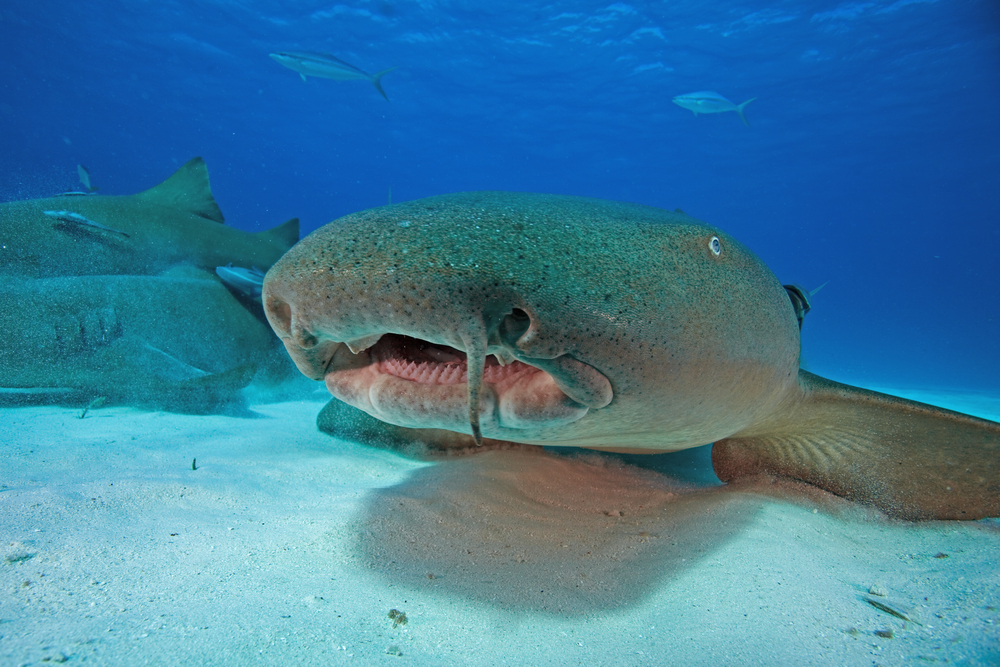The Tiger Shark (Galeocerdo cuvier) is a fascinating and formidable predator known for its distinctive appearance, feeding habits, and ecological role in marine ecosystems. Here are some key aspects that make the Tiger Shark unique:
Physical Characteristics: Tiger Sharks are large and robust sharks with a broad, flattened head, a blunt snout, and powerful jaws filled with serrated teeth. They are named for the dark vertical stripes that adorn their body, reminiscent of a tiger’s stripes, which fade as the shark matures. Their coloring ranges from bluish-gray to olive-green on the back, fading to a lighter shade on the belly, providing effective camouflage in various aquatic environments.
Size and Strength: Tiger Sharks are one of the largest shark species, with adults typically reaching lengths of 10 to 14 feet (3 to 4.3 meters) and weighing several hundred to over a thousand pounds. They possess immense strength and agility, enabling them to hunt a wide range of prey and dominate their marine environment.
Dietary Habits: Tiger Sharks are opportunistic predators with a broad diet that includes fish, seals, turtles, seabirds, dolphins, and even other sharks. They are often referred to as “garbage cans of the sea” due to their indiscriminate feeding habits and ability to consume almost anything they encounter. Tiger Sharks are known to scavenge on carrion and are attracted to sources of food such as fishing boats, garbage dumps, and even shipwrecks.
Hunting Strategy: Tiger Sharks are apex predators that use a combination of stealth, speed, and sensory capabilities to hunt their prey. They have keen senses of smell, sight, and electroreception, allowing them to detect prey from a distance and track it with precision. Tiger Sharks are known for their bold and aggressive hunting behavior, often ambushing prey from below with sudden bursts of speed.
Reproduction: Tiger Sharks are ovoviviparous, meaning that they give birth to live young rather than laying eggs. Female Tiger Sharks have relatively long gestation periods, lasting around 14 to 16 months, and typically give birth to litters of 30 to 50 pups. The pups are born fully developed and are immediately capable of swimming and hunting on their own.
Distribution and Habitat: Tiger Sharks are found in tropical and temperate waters worldwide, inhabiting coastal areas, coral reefs, and open ocean habitats. They are highly adaptable and can thrive in a wide range of marine environments, from shallow coastal waters to deep offshore reefs.
Conservation Status: Tiger Sharks face threats from overfishing, habitat degradation, pollution, and accidental capture in fishing gear. They are often targeted by commercial fisheries for their meat, fins, and liver oil, and are also vulnerable to habitat loss and degradation due to coastal development and pollution. Conservation efforts aimed at reducing fishing pressure, protecting critical habitats, and promoting sustainable fishing practices are essential for ensuring the long-term survival of Tiger Shark populations.
Cultural Significance: Tiger Sharks hold cultural significance in many coastal communities around the world, where they are often regarded with both fear and respect. They are featured prominently in folklore, mythology, and popular culture, where they are depicted as powerful and enigmatic creatures of the sea.
Tiger Sharks’ unique combination of physical characteristics, feeding habits, and ecological importance make them iconic and charismatic inhabitants of the world’s oceans. Studying and conserving these apex predators is crucial for maintaining healthy marine ecosystems and preserving biodiversity for future generations.














































































